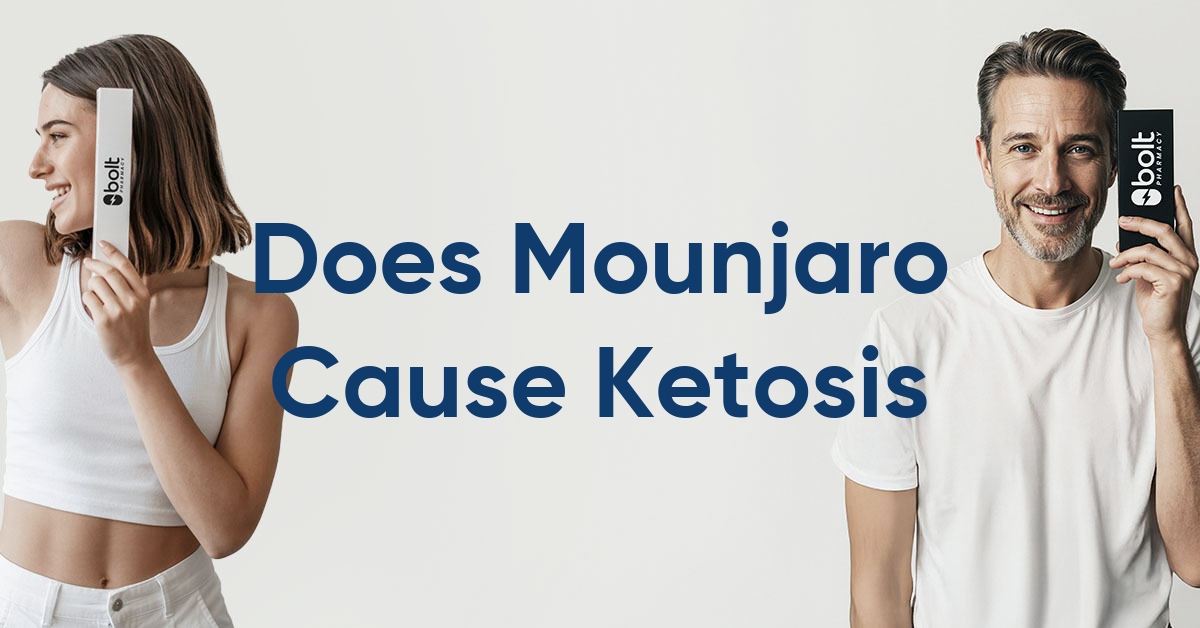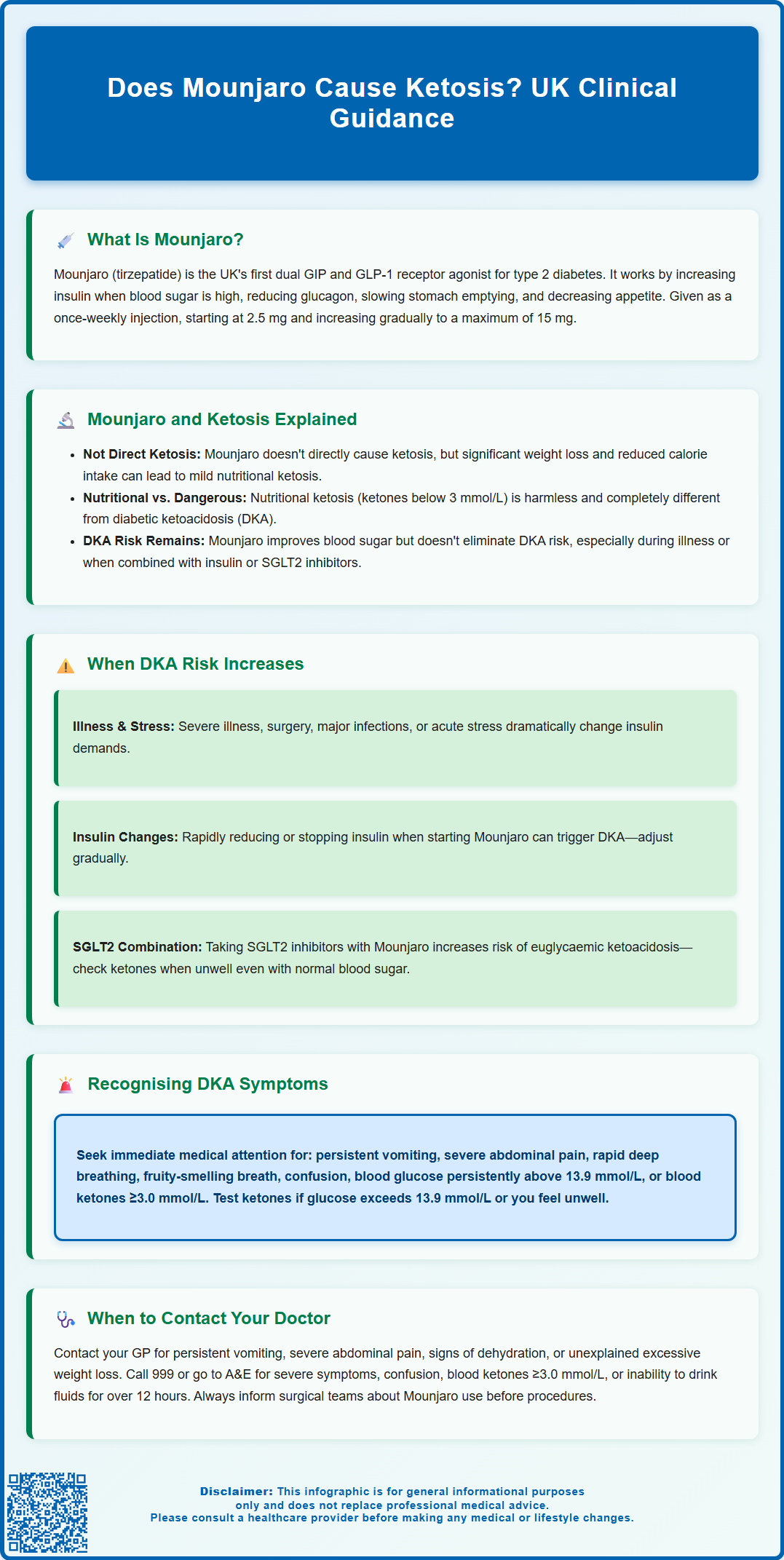Wegovy®
A weekly GLP-1 treatment proven to reduce hunger and support meaningful, long-term fat loss.
- ~16.9% average body weight loss
- Boosts metabolic & cardiovascular health
- Proven, long-established safety profile
- Weekly injection, easy to use

Mounjaro (tirzepatide) is a dual GIP and GLP-1 receptor agonist licensed in the UK for treating type 2 diabetes mellitus in adults. Many patients wonder whether Mounjaro causes ketosis, particularly given the substantial weight loss and reduced appetite commonly experienced during treatment. Whilst Mounjaro does not directly induce ketosis through its pharmacological mechanism, the significant caloric restriction it promotes can lead to mild nutritional ketosis in some individuals. This article examines the relationship between Mounjaro and ketosis, distinguishes nutritional ketosis from diabetic ketoacidosis, and provides essential safety guidance for patients and healthcare professionals.
Summary: Mounjaro does not directly cause ketosis, but the substantial caloric restriction it promotes can lead to mild nutritional ketosis in some patients as a normal metabolic adaptation.
Mounjaro (tirzepatide) is a novel glucose-lowering medication licensed in the UK for the treatment of type 2 diabetes mellitus in adults. It represents a significant advancement in diabetes pharmacotherapy as the first dual glucose-dependent insulinotropic polypeptide (GIP) and glucagon-like peptide-1 (GLP-1) receptor agonist available for clinical use.
The medication works through a sophisticated dual mechanism. By activating GIP receptors, Mounjaro enhances insulin secretion from pancreatic beta cells in a glucose-dependent manner, meaning insulin release only occurs when blood glucose levels are elevated. Simultaneously, GLP-1 receptor activation suppresses glucagon secretion from pancreatic alpha cells, slows gastric emptying, and promotes satiety through central nervous system pathways. This combined action results in improved glycaemic control and substantial weight reduction in many patients.
Key pharmacological effects include:
Enhanced glucose-dependent insulin secretion
Reduced inappropriate glucagon release
Delayed gastric emptying, leading to prolonged satiety
Reduced appetite and caloric intake
Improved insulin sensitivity, primarily through weight loss effects
Mounjaro is administered once weekly via subcutaneous injection. The recommended starting dose is 2.5 mg once weekly for 4 weeks, then increased in 2.5 mg increments at minimum 4-week intervals to a maximum of 15 mg, based on individual response and tolerability. The MHRA approved tirzepatide following clinical trials demonstrating superior glycaemic control and weight loss compared to other GLP-1 receptor agonists.
While Mounjaro's glucose-dependent mechanism reduces the risk of hypoglycaemia when used as monotherapy or with metformin, this risk increases significantly when combined with insulin or sulfonylureas. Dose reduction of these medications may be required when starting tirzepatide to minimise hypoglycaemia risk.
Mounjaro does not directly cause physiological ketosis in the manner associated with very low-carbohydrate diets or fasting states. However, the substantial weight loss and reduced caloric intake that many patients experience whilst taking tirzepatide can lead to mild nutritional ketosis in some individuals. This represents a normal metabolic adaptation rather than a pathological process.
Nutritional ketosis occurs when the body shifts towards using fat as its primary fuel source due to reduced carbohydrate availability or caloric restriction. As Mounjaro significantly suppresses appetite and delays gastric emptying, patients often consume considerably fewer calories and carbohydrates than previously. This metabolic shift can result in the production of ketone bodies (beta-hydroxybutyrate, acetoacetate, and acetone) as the liver breaks down fatty acids for energy.
Important distinctions to understand:
Nutritional ketosis is generally mild, with blood ketone levels typically below 3 mmol/L, and is not harmful in individuals without diabetes complications
This differs fundamentally from diabetic ketoacidosis (DKA), a serious medical emergency characterised by very high ketone levels, severe hyperglycaemia, and metabolic acidosis
Mounjaro improves glycaemic control but does not eliminate DKA risk; vigilance is needed during illness, fasting, or with concomitant insulin or SGLT2 inhibitor use
Patients taking both Mounjaro and SGLT2 inhibitors should be particularly cautious and check ketones when unwell even if blood glucose is not elevated, as this combination may increase the risk of euglycaemic ketoacidosis. During illness, patients should follow UK sick-day rules: maintain hydration, continue basal insulin if prescribed, check blood ketones if blood glucose exceeds 13.9 mmol/L or if feeling unwell, and seek medical advice if ketones are elevated or symptoms worsen.

Diabetic ketoacidosis (DKA) is an uncommon but serious complication in type 2 diabetes. While the absolute risk with Mounjaro remains very low, cases have been reported with GLP-1 receptor agonists, particularly when insulin is rapidly reduced or discontinued upon starting treatment. DKA occurs when severe insulin deficiency leads to uncontrolled lipolysis, excessive ketone production, hyperglycaemia, and metabolic acidosis.
In type 2 diabetes, DKA risk with Mounjaro is extremely low because these patients typically retain some endogenous insulin production. However, certain clinical scenarios may increase vulnerability. Patients with latent autoimmune diabetes in adults (LADA), those with significantly impaired beta-cell function, or individuals experiencing acute physiological stress (such as severe infection, surgery, or acute illness) may theoretically be at higher risk. Additionally, euglycaemic DKA—where ketoacidosis develops without marked hyperglycaemia—is uncommon but most frequently associated with SGLT2 inhibitors rather than GLP-1 receptor agonists. Extra vigilance is warranted if these medications are used in combination.
Risk factors that warrant particular caution include:
Severe intercurrent illness or major surgery
Significant reduction or cessation of insulin therapy
Prolonged fasting or very low carbohydrate intake
Excessive alcohol consumption
Undiagnosed type 1 diabetes or LADA
Concomitant use of SGLT2 inhibitors
The MHRA and EMA product information for Mounjaro does not list DKA as a common adverse effect, and large clinical trials have not demonstrated an increased incidence compared to placebo or active comparators. Healthcare professionals should ensure Mounjaro is prescribed only for confirmed type 2 diabetes and not for patients with type 1 diabetes, where DKA risk would be substantially elevated.
Early recognition of diabetic ketoacidosis is crucial for prompt treatment and prevention of serious complications. Whilst DKA is rare with Mounjaro use in type 2 diabetes, patients and healthcare professionals should remain vigilant for warning signs, particularly during intercurrent illness or other physiological stress.
DKA typically develops over hours to days and presents with a constellation of symptoms reflecting metabolic decompensation. Classical features include persistent hyperglycaemia (though euglycaemic DKA can occur), excessive thirst (polydipsia), and increased urination (polyuria) as the body attempts to excrete excess glucose and ketones. As acidosis develops, patients experience nausea, vomiting, and abdominal pain, which may be mistaken for gastroenteritis or other gastrointestinal conditions.
Key symptoms requiring immediate medical attention:
Persistent nausea and vomiting lasting more than a few hours
Severe abdominal pain
Unusual fatigue or weakness
Rapid, deep breathing (Kussmaul respiration)
Fruity-smelling breath (acetone odour)
Confusion or altered consciousness
Blood glucose levels persistently above 13.9 mmol/L (though may be lower in euglycaemic DKA)
Patients using Mounjaro should be educated about these warning signs during initiation and at regular review appointments. Those with home blood glucose monitoring capabilities should test more frequently during illness and check blood ketones if glucose exceeds 13.9 mmol/L or if feeling unwell. Blood ketone levels of ≥1.5 mmol/L require urgent medical advice, while levels ≥3.0 mmol/L or symptoms suggestive of DKA warrant immediate medical assessment.
Patients taking SGLT2 inhibitors alongside Mounjaro should check ketones if unwell even with normal glucose levels and follow sick-day rules carefully, as this combination increases the risk of euglycaemic ketoacidosis.
Safe use of Mounjaro requires appropriate patient selection, education, and ongoing monitoring. Healthcare professionals should conduct thorough baseline assessments before prescribing tirzepatide, including confirmation of type 2 diabetes diagnosis and renal function testing. According to the UK Summary of Product Characteristics (SmPC), hypersensitivity to the active substance or excipients is the only formal contraindication.
Patients should receive comprehensive counselling about common adverse effects, which predominantly involve gastrointestinal symptoms including nausea, vomiting, diarrhoea, and constipation. These effects are typically mild to moderate and diminish over time, but can occasionally lead to dehydration if not managed appropriately. Adequate hydration is particularly important, especially during dose escalation or intercurrent illness.
The SmPC recommends gradual dose titration to minimise gastrointestinal side effects: starting with 2.5 mg once weekly for 4 weeks, then increasing in 2.5 mg increments at minimum 4-week intervals to a maximum of 15 mg based on response and tolerability. When Mounjaro is used with insulin or sulfonylureas, dose reduction of these medications should be considered to minimise hypoglycaemia risk.
Patients should contact their GP or healthcare provider if they experience:
Persistent vomiting preventing adequate fluid or food intake
Severe or persistent abdominal pain (potential pancreatitis)
Signs of dehydration (dark urine, dizziness, reduced urine output)
Unexplained weight loss exceeding expected therapeutic effects
Any symptoms suggestive of ketoacidosis as previously described
Immediate medical attention (A&E or 999) is warranted for:
Severe abdominal pain with vomiting
Confusion or reduced consciousness
Rapid breathing with fruity breath odour
Blood ketone levels ≥3.0 mmol/L
Inability to keep down fluids for more than 12 hours
Patients planning surgery should discuss Mounjaro with their surgical/anaesthetic team, as some centres may advise withholding weekly GLP-1 receptor agonists pre-procedure due to delayed gastric emptying effects. During acute illness, patients should maintain hydration and follow sick-day rules.
Regular follow-up appointments should monitor glycaemic control (HbA1c), weight, renal function, and treatment tolerability. Patients should be encouraged to maintain a balanced diet despite reduced appetite and to stay well hydrated. Patients are advised to report any suspected side effects via the MHRA Yellow Card scheme.
Diabetic ketoacidosis with Mounjaro is extremely rare in type 2 diabetes, as patients typically retain endogenous insulin production. However, vigilance is needed during severe illness, with concomitant SGLT2 inhibitor use, or if insulin is rapidly reduced.
Nutritional ketosis is a mild, normal metabolic state with blood ketones typically below 3 mmol/L resulting from reduced carbohydrate intake. Diabetic ketoacidosis is a serious medical emergency characterised by very high ketone levels, severe hyperglycaemia, and metabolic acidosis requiring immediate treatment.
Check blood ketones if your blood glucose exceeds 13.9 mmol/L or if you feel unwell, particularly during illness. If taking SGLT2 inhibitors alongside Mounjaro, check ketones when unwell even if blood glucose is normal, and seek medical advice if ketones are 1.5 mmol/L or above.
The health-related content published on this site is based on credible scientific sources and is periodically reviewed to ensure accuracy and relevance. Although we aim to reflect the most current medical knowledge, the material is meant for general education and awareness only.
The information on this site is not a substitute for professional medical advice. For any health concerns, please speak with a qualified medical professional. By using this information, you acknowledge responsibility for any decisions made and understand we are not liable for any consequences that may result.
Lorem ipsum dolor sit amet, consectetur adipiscing elit, sed do eiusmod tempor incididunt ut labore et dolore magna aliqua. Ut enim ad minim veniam, quis nostrud exercitation ullamco laboris nisi ut aliquip ex ea commodo consequat. Duis aute irure dolor in reprehenderit in voluptate velit esse cillum dolore eu fugiat nulla pariatur.
Block quote
Ordered list
Unordered list
Bold text
Emphasis
Superscript
Subscript